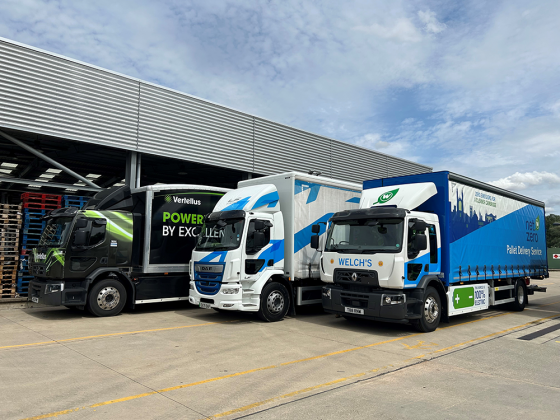eHighway: the road to low carbon freight heaven?
The freight sector still has some way to go meet greenhouse gas and emissions targets, but trials of an innovative electrified heavy goods transport system may offer one answer to the low carbon commercial vehicle conundrum.
 While electric car sales have surged over recent years, and battery-electric and hybrid cars are now widely in everyday use, the commercial vehicle sector still has much work to do to reduce its carbon footprint. Numerous initiatives and vehicles have seen progress made in the light commercial vehicle sector, but the low carbon heavy goods market is still in need of technology injections to reduce its environmental impact.
While electric car sales have surged over recent years, and battery-electric and hybrid cars are now widely in everyday use, the commercial vehicle sector still has much work to do to reduce its carbon footprint. Numerous initiatives and vehicles have seen progress made in the light commercial vehicle sector, but the low carbon heavy goods market is still in need of technology injections to reduce its environmental impact.
Purely by their size, heavy goods vehicles are more difficult to introduce alternative fuel solutions to, but one freight trial in Sweden is looking to cut the environmental impact of HGVs without disruption to their service and delivery patterns.
Over-road infrastructure
While freight can be shifted to rail networks to decrease greenhouse gas (GHG) emissions and meet ever stringent climate goals, this will not always be possible. In 2013, Siemens and Scania launched a joint project to electrify road freight transport and make electrically-powered ‘e-highways’ a reality. In contrast to dynamic wireless power transfer roads which charge vehicles on the move using multiple inductive-loops buried under the road surface (GreenFleet, issue 91), the Siemens and Scania system uses over-road infrastructure to charge HGVs as they drive.
The Scania-adapted ‘eHighway’ trucks are fitted with an ‘intelligent current collector’, similar to pantographs seen on electric trains as well as a hybrid drive system. Similar in concept to electric railway networks, a lane of electrified overhead wires transfer power to the trucks, which Siemens and Scania state has an optimal efficiency level of around 80 per cent.
Powering the truck as it drives along the road is one feasible solution to the problems of electrified road freight. The sheer size and weight of heavy goods vehicles means that they are problematic when it comes to the on-board storage of electrical energy: Siemens concludes that a typical road truck weighing 40 tonnes would need 20 tonnes to batteries to travel 1,000km (621 miles).
High wheel-to-well efficiency
The electrification of road freight transport has other benefits. The direct transfer of electrical current enables the system itself to have a high wheel-to-well efficiency, around 80-85 per cent from the sub-station to the wheel, twice that of conventional diesel engines.
The eHighway also allows for electricity regeneration to either store on-board the truck itself, or to feed back to other vehicles also on the system. This also translates into lower emissions and energy costs. Operating cost reductions are also mooted, thanks to lower expenditure on maintenance.
Siemens also reports that if the system is implemented on routes with sufficient traffic volumes, the savings can cover the cost of investment. By not interfering with the road surface, it states that disruption is kept to a minimum during installation, operation and maintenance of the system. Why not under-surface technology? Siemens states that asphalt and concrete are very poor conductors, so the negative pole needed for electrically-powered HGVs has to be made part of the overhead contact line system.
The use of long sections of ‘proven’ contact line technology ensures that the lifetime cost of the infrastructure can be kept low, and Siemens says that the truck, energy supply and the electrification system itself have all been tested and declared safe. The general technology has been used for decades in rail, tram and trolleybus networks and has proved that in operation the basic concept is a reliable one.
 Active pantograph
Active pantograph
The eHighway works by constantly generating power to the hybrid trucks via sub-stations positioned along the route. A two-pole (positive and negative) ‘bipolar’ contact line system has been specially designed for the project and can generate as secure power supply at speeds of up to 90km/h.
Key to the project is the active pantograph which connects and disconnects the hybrid trucks to the contact line via carbon contact strips. Energy (750V DC) is transferred from the overhead line to the electric motor of the specially-adapted truck. The movable pantograph automatically adjusts its position under the contact line by using clever sensor technology to compensate for lateral movements of the truck as the road surface changes in the eHighway lane. Wear is also said to be minimised across the active pantograph, which not only helps the lifespan of the connection, but also again plays dividends with reduced maintenance costs.
The eHighway trucks’ hybrid system allows for the vehicle to the used electrically when connected within the infrastructure itself. It also switches between fully electric and hybrid operation when the truck has to disconnect from the eHighway network, as well as to cover the first and last mile of each journey.
The hybrid drive also maintains flexibility when it comes to traffic flow: the eHighway truck can overtake in safety when not connected to the system. This is innovative in itself, as trolleybuses can only run operate on fixed routes, whereas the eHighway trucks can break off the system when needed.
The dual nature of the powertrain also lends itself to myriad hybrid configurations (parallel, series, or combinations) with on‑board energy storage. Regenerative braking technology sees the electric motors become generators, feeding unused braking energy back into the power grid to be used by other trucks on the eHighway route. Trucks which are both braking and accelerating can exchange energy with other vehicles via the system’s overhead contact line, even those travelling up or downhill. The regeneration also has the added benefit of lowering the power consumption of the whole system.
The ‘hybrid drive’ trucks feature 360bhp 9.0-litre diesel engines (compressed natural gas is another fuel option) which have been configured to run on biofuel, in addition to the 150kW (201bhp) electric motor. The on-board 5kWh lithium-ion battery pack can store 3 kilometres’ (1.8 miles) worth of energy for electric driving when not connected to the eHighway wires. The hybrid HGVs produce zero local emissions.
Eliminate local emissions
The Siemens-Scania collaboration first showed what an electric truck could look like in 2012, and the first eHighway trials started in California two years later. A demonstration project with Volvo Group and its subsidiary Mack Trucks – as well as conversion specialist Transpower – saw overhead lines installed in the area surrounding the ports of Los Angeles and Long Beach for four trucks to use, with the aim to completely eliminate local emissions, including harmful nitrogen oxides.
A two-mile stretch of road in the city of Carson serves thousands of trucks on a daily basis and so was the perfect candidate for the project. The results will be overseen by Southern California’s South Coast Air Quality Management District (SCAQMD), which wants to determine whether the eHighway system is suitable for long-term commercial use in the area as it seeks to introduce an emission-free solution – the ‘Zero Emission I-710 Project’ – for a section of Highway 710, which currently carries a high proportion of shuttle truck traffic.
Matthias Schlelein, head of Siemens Division Mobility and Logistics in the USA said: “Our eHighway technology eliminates local emissions and is an economically attractive solution for freight transport on shuttle truck routes. Long Beach and Los Angeles, the two US ports generating the most traffic, can benefit hugely from our technology.
“This project will help us evaluate the feasibility of a zero-emission cargo movement system using catenary,” said Barry Wallerstein, SCAQMD’s executive officer. “Southern California’s air pollution is so severe that it needs, among other strategies, zero- and near-zero emission goods movement technologies to achieve clean air standards.”
Non-fossil-dependent transport sector
The Swedish Transport Administration to the County Council of Gävleborg has also awarded a contract for the eHighway system. A two-kilometre (1.24km) length of the E16 highway just north of Stockholm will form the next part of the pilot project and connects the industrial regions of Dalarna and Gävleborg.
A pair of Scania G360 hybrid and active pantograph-equipped trucks will use the eHighway. Scania states that the trial is the first of its kind on a public road in the world, the regular traffic running alongside the electrified lane. Alongside rail, the Sweden eHighway will play a potentially essential role in achieving the goal of a non-fossil-dependent transport sector in the country by 2030.
Göran Persson, Head of Infrastructure and Cities at Siemens said: “Sweden’s aim of fossil‑free freight transport and access to fossil-free electricity creates a positive political climate for this type of technology. The Swedish Transport Administration’s latest report has also shown that they are reviewing the possibilities for different test areas. This makes Sweden a very interesting market for us. Together with Scania, we are now taking a big step forward in being able to supply a finished product.”
A trebling of global freight transport volumes between 2000 and 2050 is forecast by the World Business Council for Sustainable Development (WBCSD) and it is thought that railway networks will only be able to handle a third of the projected additional traffic. With the majority set to be transported by road, CO2 emissions and GHGs will inevitably increase, so alternative solutions will have to be found. The eHighway provides just one vision of an electrified freight network. Described as being twice as efficient as conventional internal combustion engines, the outcome of the Scania and Siemens eHighway trials will be watched with great interest by the freight sector.
Further information
sie.ag/2auglIX






